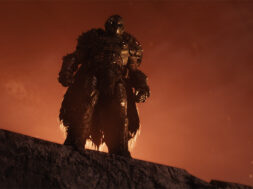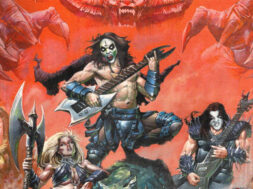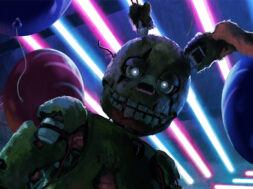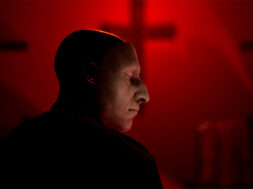Last week, Nintendo’s first console foray into the new millennium, the Nintendo Gamecube, hit the age (in North America) where if it were a human, could finally play some of its own games. Some critics will point to the Gamecube keeping with Nintendo’s “kid-friendly” attitude as a reason for older fans to stay away. That’s kind of ridiculous, as there were plenty of horror and other mature games on the system, with some of them today being bona fide classics.
So, because it’s the internet thing to do, here are 18 horror/genre games for each of the 18 years of the Gamecube. Some of them are age-appropriate, while others defy that sort of talk.
Resident Evil Zero, REmake, Resident Evil 2, Resident Evil 3: Nemesis, Resident Evil Code: Veronica X, Resident Evil 4

Let’s just get this out of the way: Capcom gave a lot of love to the Gamecube. Sure, RE2 and RE3 were essentially quick port jobs of the PlayStation originals, and Code: Veronica X was a port of the PlayStation 2 version, but then you had the start of Capcom’s project of remaking the series with Resident Evil. The remake was revamped in every way possible, bringing with it improved graphics and presentation, music, and new surprises for veterans of the original. It still kept the tank controls, though. After that you had a prequel in Resident Evil Zero. While not as well-received as REmake, the atmosphere was still top notch. Zero also moved the series towards more of an action-oriented affair.
Which, of course, brings us to the game that essentially saved the series, Resident Evil 4. Part of a short-lived exclusivity deal with Nintendo, RE4 ditched the 3rd-person view, puzzles and tank controls, and instead embraced an over-the-shoulder perspective, bringing with it a more action and less of an emphasis on survival horror than the previous games. RE4 became one of the biggest games of the 2000s, pioneered the “over-the-shoulder” camera view, and set the tone for the series for the next decade. If there was one game you had to get for the Gamecube, Resident Evil 4 is it.
Eternal Darkness: Sanity’s Requiem

And then there’s the other big horror game for the system in Eternal Darkness. The Silicon Knights title features similar gameplay mechanics to that of Resident Evil, but the big draw was the game’s “sanity effects”. You took control of one of four main characters across four time periods, which the game skips back and forth between them. The story concerns Alexandra Roivas, who arrives at her family’s estate in Rhode Island after her grandfather, Edward Roivas, is found brutally murdered. Alexandra begins searching the mansion for clues as to who did it, and eventually uncovers the Tome of Eternal Darkness. From there, the game jumps from character to character.
That’s only the start of the weirdness. The game employs a Sanity Meter (an actual Nintendo patent), which players need to keep topped up. As the meter becomes low, environmental changes and random events start to occur, reflecting the character’s grip on reality. There are minor things, such as a skewed camera angles and disturbing noises, but when things got hairy, you had walls and ceilings start to bleed, the character suddenly dying, fourth wall-breaking effects, and even simulated errors involving your TV or GameCube! If you’ve had your TV “signal” suddenly go out while you were playing the game, you know that was often more frightening than the actual game.
Luigi’s Mansion

Mario takes a backseat this time, as Luigi is the star. The story goes that Luigi is notified that he’s won a mansion in a contest he did not enter. He informs Mario, and they agree to meet up outside the mansion that evening. When Luigi arrives at the creepy-looking mansion, Mario is nowhere to be found. Upon entering the mansion Luigi is attacked by a ghost, but is saved by a scientist, Professor Elvin Gadd. E. Gadd tells Luigi that he saw Mario heading towards the mansion, but has not seen him since. Utilizing the Poltergust 3000 and Game Boy Horror communication device given to him by E. Gadd, Luigi sets out to catch ghosts and find Mario.
A launch title for the Gamecube, some fans were let down that Mario wasn’t the protagonist. But once people played the game, Luigi’s Mansion was a winner. The title sold more that 2.5 million units, and became the best-selling Gamecube title. The mechanics of ghost-hunting using the Poltergust 3000, a high powered vacuum cleaner, were charming and fun, and gave fans a taste of being a Ghostbuster long before Ghostbusters: The Video Game arrived. And the graphical touches, such as Luigi’s breath or the way objects in the mansion reacted to being stuck in the suction, only added to it all. The game’s success led to the creation of its own series, which continues today with Luigi’s Mansion 3.
Metal Gear Solid: Twin Snakes

Just prior to the release of Metal Gear Solid 3: Snake Eater (which wasn’t coming to the Gamecube), Konami sought to at least given Nintendo fans a treat with a remake of the original Metal Gear Solid and Metal Gear Solid 2: Sons of Liberty in one package. The result is a unique offering exclusive to the Gamecube that merges the gameplay mechanics found in MGS2 into the original MGS. The revamped Metal Gear Solid now allowed players to use the first-person camera to shoot, as well as giving the enemy AI the ability to communicate with each other, and better detect the player.
Not only that, but Metal Gear Solid also featured re-recorded dialogue (including new quotes by Psycho Mantis as he read your memory card), and brand new cutscenes that were directed by Versus and Midnight Meat Train director, Ryuhei Kitamura. Konami also added a few new easter eggs to the games, such as cameos by Mario and Yoshi, the actual Gamecube and Wavebird wireless controller, and thanks to co-developer Silicon Knights, a few appearances of Eternal Darkness. While some of the challenge in Metal Gear Solid is compromised due to the new camera, the game remains just as fun and engrossing as the PlayStation original. Meanwhile, Metal Gear Solid 2 is the same “ahead of its time” greatness, even if Raiden started out being an unlikeable bait-and-switch by Kojima.
Killer7

If you thought Kojima’s writing was weird and complex, think again. Suda51 presents a story involving an alternate future where the world achieves peace and nuclear disarmament, only to have a new terrorist group called “Heaven Smile” appear to wreak havoc. Its members are infected with a virus that gives those infected an increased desire to kill. Factory-produced Smiles are given a “bomb-organ” that allows them to explode at will. As a result, a group of assassins called the “killer7”, led by an wheelchair-bound elderly man named Harman Smith, are hired to stop the Heaven Smile. Smith exhibits “Multifoliate Personae Phenomenon”, which allows him to physically transform into one of his seven assassin personae.
Killer7 was Suda51’s first game outside of Japan, and in keeping with his unorthodox writing and direction, Killer7 was as stylistic as it was polarizing. It was acknowledged that the title, with its complex (and just plain bizarre) story, unique graphical style and gameplay, was destined to be a cult game. Switching between seven wildly different characters at will and hunting down invisible enemies, all the while being confined to what was essentially a rail shooter, doesn’t exactly scream “mainstream appeal”. Nevertheless, Killer7 won over those who gave it a try. It also paved the way for Suda51’s breakout hit, No More Heroes. If you like your strange games, Killer7 is for you.
Bloodrayne

Battling Nazis as a vampire? Why not? Bloodrayne‘s story revolves around Rayne, a dhampir (half human, half vampire) and agent of the Brimstone Society. Set in 1933 and 1938, just before World War II, Rayne is sent to various locations around the world to battle supernatural creatures. Eventually, Rayne learns of the Gegengeist Gruppe, a group that aims to bring Hitler into power through use of occult artifacts, including obtaining and reassembling the remains of Beliar, a demon whose remains (as relics) grant their owners supernatural abilities.
It’s admittedly a mish-mash of clichés, and the first level is pretty lame, but Bloodrayne can still be a moderately fun mix of melee combat and gunplay. And who doesn’t love chomping into Nazis? It’s not the most deep game, but how many games can have you slicing up or shooting up Nazis while also sucking out their blood?
Blood Omen 2

Four hundred years after the events of Blood Omen: Legacy of Kain, Kain awakens in Meridian, Nosgoth’s industrial capital city. He remembers very little, and is lacking much of his former power. He is greeted by a vampire called Umah, who informs Kain that he has been asleep for two hundred years. It turns out that Kain’s conquest of Nosgoth had been opposed by an army of vampire hunters called the Sarafan Order, who defeated Kain and his army. The Order’s leader, the Sarafan Lord, then claimed the Soul Reaver from Kain. After their victory, the Sarafan have imposed harsh martial law on Nosgoth’s human population, started an industrial revolution, and have hunted the remaining vampires to near extinction. Umah is a member of the Cabal; an underground resistance movement formed of vampires. The Cabal tasks Kain with destroying the Sarafan, their leader, and the traitorous vampires that protect him.
Much like they did with the first Blood Omen, Crystal Dynamics were able to craft a compelling game in Blood Omen 2 steeped in lore and atmosphere. Unfortunately, the game lacks the newer gameplay elements introduced in Soul Reaver 2, which was being developed at the same time. Instead, the game goes back to the door-and-switch affair with so-so combat seen in the first Soul Reaver, which at this point, had gotten old quite quickly. Still, despite the repetition, there’s certainly enough charm that fans of the original will glean from it. Sadly, it only makes you wish for a resurrection of the series.
Geist

John Raimi is a scientist assigned to the counter-terrorist team CR-2 that’s on a mission to extract an undercover agent from a mysterious facility owned by the Volks Corporation. The facility has been secretly developing a chemical or biological agent, and it’s your mission to secure a sample. After rendezvousing with the undercover agent, things take a turn for the worse as most of your team is killed, and you end up the victim of a procedure that removes your spirit from your physical body. Lacking a corporeal form, you must now haunt the gloomy halls of the facility as you attempt to recover your human body and uncover the secrets of the Volks Corporation. Luckily, you now have the ability to possess other living beings in order to even the odds.
Armed with a unique premise, Geist does quite a good job injecting something new into a then-crowded room of first person shooters. Body-hopping recalls a similar feature from Shiny’s Messiah, though in Geist you have puzzles to contend with that require possessing inanimate objects, as well. The single-player campaign is a little on the short side (10 hours), but the three multiplayer modes make up for it with the humans-and-ghost mechanic. There are some technical issues with the game, such as choppiness and some dated-looking graphics when compared to its contemporaries. However, it’s a perfectly adequate shooter for the Gamecube.
Second Sight

John Vattic wakes after an absurdly long coma, bloodied and bandaged in a government building. Without a clue as to where he is or even who he is, John slowly discovers that his mind brims with all manners of psychic powers. He can move things by thought alone, heal himself with brain power and even project himself out of his body. Unfortunately for John, there are now also government types after him. John sets out to discover how he ended up in this state and why so many shady characters seem to be after him. Along the way, John has recurring flashbacks to a mission involving him investigating the doings of a crazed scientist in Russia that may hold more answers as to his current predicament.
On the plus side, Second Sight sports a good X-Files type story with strong voice acting. Sadly, the game is bogged down by so-so visuals (though they have that TimeSplitters charm to them, thanks to developer Free Radical) and a weak combat system with mundane weaponry. The game also doesn’t present much of a challenge in its difficulty. It pales in comparison to Metal Gear Solid, but Snake never had psionic powers at his disposal. It’s a weekend affair, but at least you’ll have some fun doing it.
Monster House

Following the plot of the 2006 animated film of the same name, Monster House involves three kids: D.J., Chowder and Jenny. When D.J.’s parents leave for the weekend, he is left in the care of teenage babysitter, Zee. Together, with D.J.’s best friend, Chowder, the trio discover that D.J.’s neighbour’s house is an actual living monster that eats people. After being left in the back of a police car (which is eaten), the trio must navigate to reunite with each other, destroy the house and escape.
Film-based games have always had a good chance of being on the lame side, and while Monster House‘s premise screams of being ripe for a video game, the result is only okay. Sure, the game captures the feel of the movie, but the overall gameplay is too simplistic, despite the three playable characters feeling distinct from one another. Further adding to the frustration is the lock-on mechanic that makes it tough to keep track of enemies, along with the distorted camera that gives everything a fish-eye lens look. Toss in some pedestrian adventure game puzzles like block moving or “find object X in order to unlock area Y” stuff, and you have a game that might be more for the younger crowd, won’t hold a candle to older gamers.
Buffy The Vampire Slayer: Chaos Bleeds

After having to stave off an onslaught of vampires at the Magic Box, Buffy and crew learn from one vampire the threat of impending destruction, courtesy of head vampire Kekistos. Turns out that Ethan Rayne is at the center of a great struggle with The First, literally the first incarnation of evil. What ensues involves Buffy and the gang encountering different alternate realities bleeding into their own reality, leading to the reappearance of deceased enemies and the appearance of evil versions of allies.
Serving as a “lost episode” for the second half of the fifth season, Chaos Bleeds is a fun tie-in for fans of the show. Despite the downgraded visuals and the tendency to devolve into button-mashing, the game offers quite a bit of enjoyment. There are plenty of vampires and demons to kill, with a variety of implements. Multiplayer is also a bit of a surprise, offering up some unique modes for friends to have a fun evening. There are also unlockable extras via collectibles that give you interviews, behind-the-scenes footage and even a Chaos Bleeds tie-in comic book.
Spawn Armageddon

A group of renegade angels have launched a massive weapon straight into the depths of hell in an attempt to destroy it. Unfortunately, the side effect of this weapon strike is that hell’s minions now have an easy exit topside to the earth’s surface. Spawn must now do clean up duties. Complicating matters is an escaped experimental supersoldier, Cy Gor, developed by Spawn’s primary earthly adversary, Jason Wynn.
Sadly, Spawn Armageddon relies on the license to do its work, as the game doesn’t offer much. Combat gets old pretty quickly, with Spawn’s powers being so difficult to aim properly, and his basic axe attack doing the same three moves. In fact, you can beat some of the bosses by just finding the right spot and launching your chains at them. It also doesn’t help that the AI is inept. Toss in some poorly-designed levels and gameplay mechanics (yay, platforming), suspect control issues and a painfully (or mercifully) short completion time of six hours, and you’d probably be better off playing as Spawn in Soul Calibur 2. At least you can unlock some encyclopedic stuff like concept art and comic book covers.
Hunter: The Reckoning

Based on White Wolf’s World of Darkness tabletop RPG, the town of Ashcroft is besieged by the undead after a rave in an abandoned prison opens a previously-sealed rift between the world of the living and the deceased, allowing the aforementioned undead to awaken. As one of four hunters who had previously sealed the rift, you’ll take on the hoard of undead, solve the mystery behind the rise of the dead, and save the town from damnation.
Coming across as a mix of Gauntlet and Smash T.V., Hunter is quite fun, especially when playing with other people. The game is sadly on the short side, and the extras you’re rewarded with after completing the game really don’t provide much incentive to go back and play through it all again. However, the four characters available to play as are balanced quite well, requiring you to have a bit of strategy when playing. That’s on top of working together as a team, should you and (up to) three of your friends decide to go at it.









